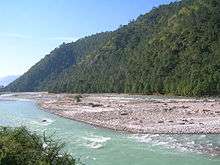White-bellied heron
The white-bellied heron (Ardea insignis), also known as the imperial heron or great white-bellied heron, is a species of large heron known from the foothills of the eastern Himalayas in India and Bhutan to northeastern Bangladesh and Burma.[2] It is mostly solitary and occurs in undisturbed riverside or wetland habitats. It has been listed as Critically Endangered on the IUCN Red List since 2007, because the global population is estimated at less than 300 mature individuals and threatened by disturbance and habitat degradation.[1]
| White-bellied heron | |
|---|---|
| White-bellied heron (Ardea insignis) at Pho Chu, Bhutan. | |
| Scientific classification | |
| Kingdom: | Animalia |
| Phylum: | Chordata |
| Class: | Aves |
| Order: | Pelecaniformes |
| Family: | Ardeidae |
| Genus: | Ardea |
| Species: | A. insignis |
| Binomial name | |
| Ardea insignis Hume, 1878 | |
 | |
| Synonyms | |
| |
It is mostly dark grey with a white throat and underparts.
Taxonomy and systematics
This heron was first noted as the "great Indian heron" in JE Gray's Zoological Miscellany of 1844 based on Brian Houghton Hodgson from Nepal.[3] Allan Octavian Hume noted its distinctiveness and pointed out the differences between it and Ardea sumatrana.[4] The alternate name of Ardea imperialis was suggested by Stuart Baker, since Hodgson's name was a nomen nudum and this was used in Peters' check-list.[5] This was used until 1963, when Biswamoy Biswas commented on Sidney Dillon Ripley's synoptic list and noted that Ardea insignis Hume should be used, since its citation as a synonym of Ardea nobilis Blyth and Ardea sumatrana Raffles was based on misidentification.[6][7]
Description
This large heron is plain dark grey above with a long neck. The crown is dark and there are no black stripes on the neck as in the grey heron. In breeding plumage, it has a greyish-white nape plume and elongated grey breast feathers with white centers. The bill is black, greenish near the base and tip and the face is greenish grey. The bill is large and solid, with the culmen measuring 15.2–17.6 cm (6.0–6.9 in).[8] The chin and central portion of the underside are whitish in color (per the common name), contrasting strongly against the dark grey color on the back. The legs are blackish with scale-like texture on the tarsus which measures 17.1 to 21.6 cm (6.7 to 8.5 in).[9] In flight, it has a uniform dark grey upperwing and white underwing-coverts contrasting with dark grey flight feathers. The rump appears paler grey.[10] At 127 cm (50 in) in height, it is the second largest heron on earth, after the Goliath heron. Included in the length, the mid-sized tail measures 19.9 to 21.6 cm (7.8 to 8.5 in). The wing chord measures 54.6 to 57.2 cm (21.5 to 22.5 in), with an estimated wingspan of 2 m (6.6 ft) or more.[9] One estimate of body mass was relatively low at 2–2.6 kg (4.4–5.7 lb), however a deceased juvenile of the species reportedly weighed much more at 5.6 kg (12 lb).[11][12] Another dead juvenile heron stood 1.58 m (5.2 ft) tall and weighed 8.51 kg (18.8 lb).[13] These extremely high weights require verification, since they indicate this species can exceed even the typically larger Goliath heron in mass. On the ground it walks slowly, moving its neck slowly while looking from side to side. The Goliath species, beyond the average size difference, is distinguished by its chestnut neck while the slightly smaller great-billed heron is solid grey necked with the underside of the wings all grey.[14]
The usual call given when disturbed is a deep croak.[14]
Distribution and habitat

The white-bellied heron is found in the wetlands of tropical and subtropical forests in the foothills of the eastern Himalayas of India and Myanmar. It also occurs in Bhutan's sub-tropical areas and was once found in Nepal. The major threats the heron faces are poaching (both the bird itself and its eggs) and habitat destruction (cutting of nesting trees and the disappearance of wetlands).
In Bhutan, white-bellied herons are found along the Punatsang Chu river especially in Pho-chhu river banks in Toewang Gewog, along Kami Chhu river) and in Lower Kheng (Berti). It can also be found in Madgechhu (Trongsa). A recently discovered nesting site in the Namdapha national park and Tiger Reserve in Arunachal Pradesh, India, is the first such breeding site outside of Bhutan.[15]
Status and conservation
This species is rarer than previously believed. Indeed, it appears close to extinction. It has therefore been uplisted from endangered to critically endangered status in the 2007 IUCN Red List.[1] In Bhutan, white bellied herons are found in the low elevation riparian habitat below 1700 m, particularly in the Punatsang Chhu (river) basin. About 30 individual birds are known within the river valley of Bhutan in the Punakha-Wangdiphodrang district in west central part of the country. It is under grave threat of extinction in Bhutan due to accelerated development of large-scale hydro-power projects in the basin. Rising water levels force the nesting birds to search extensively for fish, leaving the eggs or chicks exposed to predators such as the crested serpent eagle.
A nesting site of white-bellied heron has been discovered in a remote part of the Namdapha Tiger Reserve in Arunachal Pradesh in 2014. It is estimated that there are only 250 white-bellied herons (Ardea insignis) left in the world and only about 50 left in India. The Department of Science and Technology, Government of India, has funded a three-year study on the species with a view to document the foraging behaviour of the critically endangered bird.[16]
References
- BirdLife International (2018). "Ardea insignis". IUCN Red List of Threatened Species. 2018: e.T22697021A118359844. doi:10.2305/IUCN.UK.2018-2.RLTS.T22697021A134201407.en.{{cite iucn}}: error: |doi= / |page= mismatch (help)
- Ali, S. (1993). The Book of Indian Birds. Bombay: Bombay Natural History Society. ISBN 0-19-563731-3.
- Blanford WT (1898). Fauna of British India. Volume 4. Taylor and Francis, London. pp. 383–384.
- Hume,AO & Davison,W (1878). "A revised list of the birds of Tenasserim". Stray Feathers. 6 (1–6): 1–524.
- Mayr E; G W Cottrell, eds. (1979). Check-list of the birds of the world. Volume 1 (2nd ed.). Museum of Comparative Zoology. p. 201.
- Walters, Michael. "The correct scientific name of the White-bellied Heron". Bulletin of the British Ornithologists' Club. 121 (4): 234–236.
- Biswas, B (1963). "Comments on Ripley's A synopsis of the birds of India and Pakistan". J. Bombay Nat. Hist. Soc. 60 (3): 679–689.
- del Hoyo, J; Elliot, A; Sargatal, J (1996). Handbook of the Birds of the World. 3. Barcelona: Lynx Edicions. ISBN 84-87334-20-2.
- White-bellied Heron – Ardea insignis. Avis.indianbiodiversity.org. Retrieved on 2012-08-22.
- Rasmussen PC & JC Anderton (2005). Birds of South Asia: The Ripley Guide. Volume 2. Smithsonian Institution & Lynx Edicions. p. 57.
- Hildyard, Anne, Endangered Wildlife and Plants of the World: Vol. 5 Fra-Igu. Marshall Cavendish Corp. (2001), ISBN 978-0-7614-7199-8
- Juvenile White-bellied heron released. Royal Society for Protection of Nature (RSPN), Thimphu: Bhutan (2011-09-17).
- The Bhutan Observer The Independent Voice (2008-08-29)
- Kushlan, James Anthony; James Hancock (2005). Herons: Bird families of the world. Oxford University Press. pp. 120–123. ISBN 0-19-854981-4.
- "India’s first nesting site of white-bellied heron found", The Hindu, Kolkata, 16 November 2014.
- Singh, Shiv Sahay (2014-11-15). "India's first nesting site of white-bellied heron found". The Hindu.
External links
- BirdLife Species Factsheet
- White-bellied heron photos by Yeshey Dorji
- White-bellied heron video by Bhutan Bird Quest
